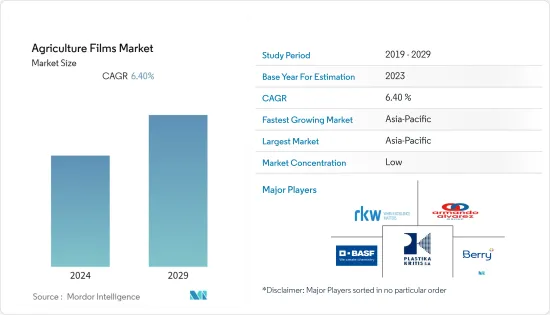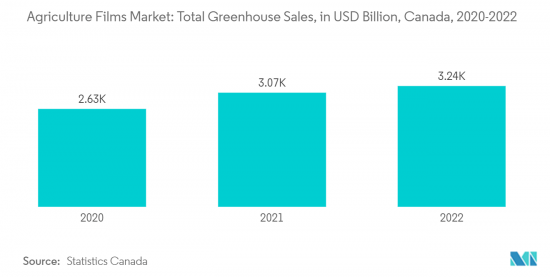PUBLISHER: Mordor Intelligence | PRODUCT CODE: 1403927

PUBLISHER: Mordor Intelligence | PRODUCT CODE: 1403927
Agriculture Films - Market Share Analysis, Industry Trends & Statistics, Growth Forecasts 2024 - 2029

The global agricultural films market size is expected to grow from USD 11.7 billion in 2024 to USD 16.03 billion by 2029, at a CAGR of 6.40% during the forecast period.
Key Highlights
- The increasing adoption of protected cultivation practices, the focus on enhancing agricultural output, the adoption of mulching films, and the escalating demand for biodegradable films are driving the agricultural film market. The rising global population and declining arable land are raising food security concerns worldwide, bolstering the demand for agricultural films to improve agricultural productivity. Agricultural films help in soil protection, greenhouse farming, and mulching. They also provide the benefits of reduced soil erosion and compaction, temperature control, nutrient conservation, seed germination, weed control, and UV protection.
- As environmental concerns continue to rise, the demand for biodegradable agricultural films is poised to grow in the foreseeable future. These eco-friendly alternatives play a vital role in weed suppression, temperature regulation, soil nutrient and moisture preservation, and enhancing plant stability. Additionally, various governments worldwide are actively promoting sustainable agriculture and eco-friendly farming practices, further bolstering the market's prospects in the coming years.
Agriculture Films Market Trends
Shift Towards Protected Agriculture Drives the Demand for Agriculture Films
- Due to the growing global population and increasing food security concerns, protected agriculture is gaining immense traction as it helps extend the growing season of crops and produce higher yields. This, in turn, drives the demand for agricultural plastics for securing and significantly increasing produced output per hectare while enhancing crop quality. These films also aid in reducing the crop spoilage risk associated with weather, pests, and weeds and improving the overall crop quality, particularly in greenhouses, throughout their life cycle. Moreover, polyethylene is a widely used material for agricultural films to protect crops and improve crop yield in greenhouses and tunnels.
- According to StatCan, there were 892 greenhouse fruit and vegetable operations in Canada in 2021, up from 858 the previous year. This increased consumption of fruits and vegetables in Canada drives investments in greenhouses, boosting the demand for agricultural films in the country. With expanding greenhouse farming areas and the rising adoption of protected farming practices, the agricultural film market is expected to grow during the forecast period.
- Apart from this, manufacturers are using a wide range of additives, such as agrochemical resistance, ultraviolet (UV) absorbers, and anti-fogging agents, to improve the lifespan and effectiveness of agricultural films. Developing advanced agricultural films with technologies such as nanotechnology and ultra-thermic films will likely positively impact the demand for agricultural films shortly.

Asia-Pacific Dominates the Market
- The Asia-Pacific region occupies nearly half of the world's total area under greenhouse vegetable cultivation. Large strips of the area under greenhouse vegetables, growing emphasis on high-value and export-oriented cultivation of fruits and vegetables, and the thriving agriculture industry are key factors driving the market for agricultural films in the region. The shifting focus of consumers toward biodegradable films due to rising environmental consciousness is further acting as a significant catalyst for market growth.
- Biodegradable agricultural films are developed from various renewable feedstocks, such as corn starch, rice husk, pectin, and food waste, with zero to minimal environmental impact. Besides this, key players are focusing on product innovations like ultraviolet (UV) blocking, NIR blocking, and fluorescent and ultra-thermic films, which are expected to augment the market growth over the forecast period.
- For instance, in April 2021, an agriculture film called Smart Glass ULR-80, which Australian scientists designed for use in commercial greenhouses, was launched. This was claimed to block the solar radiation contributing to heat gain while transmitting the wavelengths plants require for photosynthesis and growth. The impacts of two novel prototype technologies, energy-reducing 'Smart Glass' film ULR-80 (SG) and LLEAF-Red film, used in this film were claimed to shift green light to red for maximum vegetative growth.
- Moreover, farmers in Asia-Pacific, particularly in China, are adopting protected agricultural practices to enhance crop productivity and quality. Almost 3.3 million hectares of crop area in China come under protected cultivation. Other large countries in the region, such as India, Japan, and South Korea, also use agricultural films in greenhouses and mulching, especially in cultivating vegetables. Therefore, the expanding cultivation of fruits and vegetables through greenhouse methods is expected to drive the market for agricultural films in the region.
Agriculture Films Industry Overview
The overall market for agricultural films is fragmented due to the presence of a few prominent players and several small-scale and regional players. Berry Global Inc., BASF SE, Armando Alvarez Group, RKW SE, and Plastika Kritis SA are some of the major players in the market. Major industry participants have been investing heavily in R&D for commercializing biodegradable and longer shelf-life products. The key companies are partnering with biotechnology firms to ensure sustainable product innovation in the future.
Additional Benefits:
- The market estimate (ME) sheet in Excel format
- 3 months of analyst support
TABLE OF CONTENTS
1 INTRODUCTION
- 1.1 Study Assumptions and Market Definition
- 1.2 Scope of the Study
2 RESEARCH METHODOLOGY
3 EXECUTIVE SUMMARY
4 MARKET DYNAMICS
- 4.1 Market Overview
- 4.2 Market Drivers
- 4.3 Market Restraints
- 4.4 Porter's Five Forces Analysis
- 4.4.1 Bargaining Power of Suppliers
- 4.4.2 Bargaining Power of Buyers
- 4.4.3 Threat of New Entrants
- 4.4.4 Threat of Substitute Products
- 4.4.5 Intensity of Competitive Rivalry
5 MARKET SEGMENTATION
- 5.1 Type
- 5.1.1 Low-Density Polyethylene
- 5.1.2 Linear Low-Density Polyethylene
- 5.1.3 High-Density Polyethylene
- 5.1.4 Ethyl Vinyl Acetate (EVA)/Ethylene Butyl Acrylate (EBA)
- 5.1.5 Reclaims
- 5.1.6 Other Types
- 5.2 Application
- 5.2.1 Greenhouse
- 5.2.2 Silage
- 5.2.3 Mulching
- 5.2.4 Other Applications
- 5.3 Geography
- 5.3.1 North America
- 5.3.1.1 United States
- 5.3.1.2 Canada
- 5.3.1.3 Mexico
- 5.3.1.4 Rest of North Amercia
- 5.3.2 Europe
- 5.3.2.1 Germany
- 5.3.2.2 United Kingdom
- 5.3.2.3 France
- 5.3.2.4 Spain
- 5.3.2.5 Italy
- 5.3.2.6 Russia
- 5.3.2.7 Rest of Europe
- 5.3.3 Asia-Pacific
- 5.3.3.1 China
- 5.3.3.2 India
- 5.3.3.3 Australia
- 5.3.3.4 Japan
- 5.3.3.5 Rest of Asia-Pacific
- 5.3.4 South America
- 5.3.4.1 Brazil
- 5.3.4.2 Argentina
- 5.3.4.3 Rest of South America
- 5.3.5 Africa
- 5.3.5.1 South Africa
- 5.3.5.2 Egypt
- 5.3.5.3 Rest of Africa
- 5.3.1 North America
6 COMPETITIVE LANDSCAPE
- 6.1 Most Adopted Strategies
- 6.2 Market Share Analysis
- 6.3 Company Profiles
- 6.3.1 AB Rani Plast Oy
- 6.3.2 BASF SE
- 6.3.3 Berry Global Inc.
- 6.3.4 Plastika Kritis SA
- 6.3.5 Novamont SpA
- 6.3.6 ExxonMobil Chemical
- 6.3.7 Armando Alvarez Group
- 6.3.8 Group Barbier
- 6.3.9 RKW SE
- 6.3.10 INDVECO Group
7 MARKET OPPORTUNITIES AND FUTURE TRENDS




